Tomato-based sauces and cream-enriched recipes are your best choices for solar cooking success. You'll find these sauces develop deeper, richer flavors through the slow, gentle heating process that sun cooking provides. Start with simple recipes like sun-dried tomato sauce or creamy Tuscan blends, using dark-colored pots with tight-fitting lids for ideal heat absorption. Make sure you're cooking between 11 am and 3 pm when sunlight is strongest, and always maintain temperatures above 165°F for food safety. Consider using natural thickeners like pureed vegetables or cornstarch slurries instead of traditional roux. Our expert techniques will help you master the art of solar sauce-making.
Essential Solar Cooking Equipment
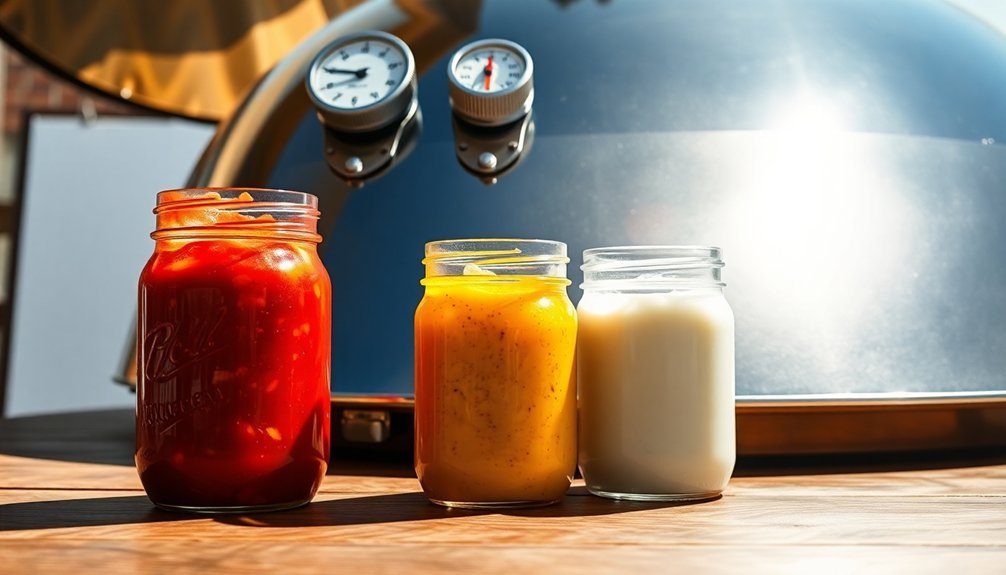
When setting up your solar cooking station, you'll need several essential pieces of equipment to effectively harness the sun's energy.
Start with a dark-colored pot that has a tight-fitting lid to maximize heat absorption and retention. You'll want to place this inside a cardboard box lined with aluminum foil and black construction paper.
Create a transparent heat trap using plastic wrap or a clear plastic sheet over the top of your box. Adding a reflective flap on top helps direct more sunlight into the cooking chamber. Add insulating materials like newspaper or foam board around the sides.
For sauce-making specifically, use glass dishes or heavy-duty plastic bags for liquid ingredients. Don't forget to include a thermometer to monitor cooking temperatures and utensils for stirring.
Position your setup in direct sunlight between 10:00 a.m. and 2:00 p.m., using a stand or stones to optimize heat capture.
Understanding Solar Cooking Times
Now that you've assembled your solar cooking setup, mastering the timing will help you achieve perfect results. You'll get the best cooking performance between 11 am and 3 pm, when the sun's rays are strongest. Start around 10 am if you need to preheat or brown ingredients.
Your sauce cooking times will vary based on several factors. Higher temperatures speed up the process, while clouds and wind can extend it. You'll want to use dark, thin metal pots for ideal heat absorption. Granite ware and cast iron are particularly effective pot choices for solar cooking.
Keep monitoring your cooker's temperature and adjust its position to track the sun. Most sauces take between 1-2.5 hours to cook properly, though thicker or meat-based sauces might need up to 3 hours.
Consider using reflectors to boost performance, especially in temperate regions.
Simple Sun Dried Tomato Sauce
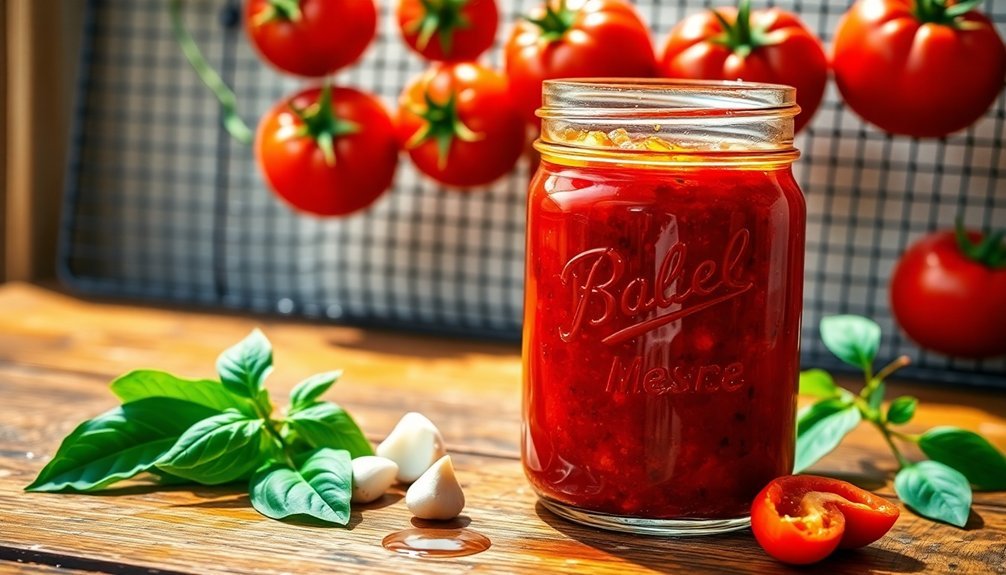
Creating a flavorful sun-dried tomato sauce in your solar cooker starts with gathering fresh ingredients and preparing them properly.
You'll need ¾ cup high-quality olive oil, 3 cloves of fresh garlic, and 3 ounces of chopped sun-dried tomatoes. For herbs, combine dried oregano, basil, thyme, and rosemary, with optional red chili flakes for heat. Beginning with dry tomatoes requires soaking for 20 minutes in warm water before cooking.
In your solar cooker, heat the olive oil and sauté the garlic until fragrant. Add your sun-dried tomatoes and herbs, stirring continuously.
You can adjust the consistency using starchy pasta water or heavy cream for a richer version. Once completed, you'll have a versatile sauce that's perfect for pasta, pizza, or as a dip.
Store any leftovers in a mason jar for up to two weeks in the refrigerator.
Creamy Tuscan Solar Recipe
Though traditional Tuscan cream sauces require stovetop cooking, this solar-powered version delivers the same rich, authentic flavors while harnessing the sun's energy. You'll start by combining heavy cream, chicken broth, and parmesan in your solar cooker, then add garlic and Italian seasoning for depth. The quick preparation time makes this an efficient solar cooking option that takes just 10 minutes to assemble ingredients.
| Ingredient | Solar Cooking Tip |
|---|---|
| Heavy Cream | Place in shallow pan for even heating |
| Sun-dried Tomatoes | Pre-soak to reduce cooking time |
| Fresh Spinach | Add during final 10 minutes |
| Parmesan | Stir frequently to prevent clumping |
For protein variations, you can include pre-cooked chicken, shrimp, or Italian sausage. The sauce will thicken naturally under the solar heat, but you'll want to stir occasionally. Once ready, serve over pasta or your favorite sides, garnishing with fresh basil and extra parmesan.
Temperature Control For Sauces
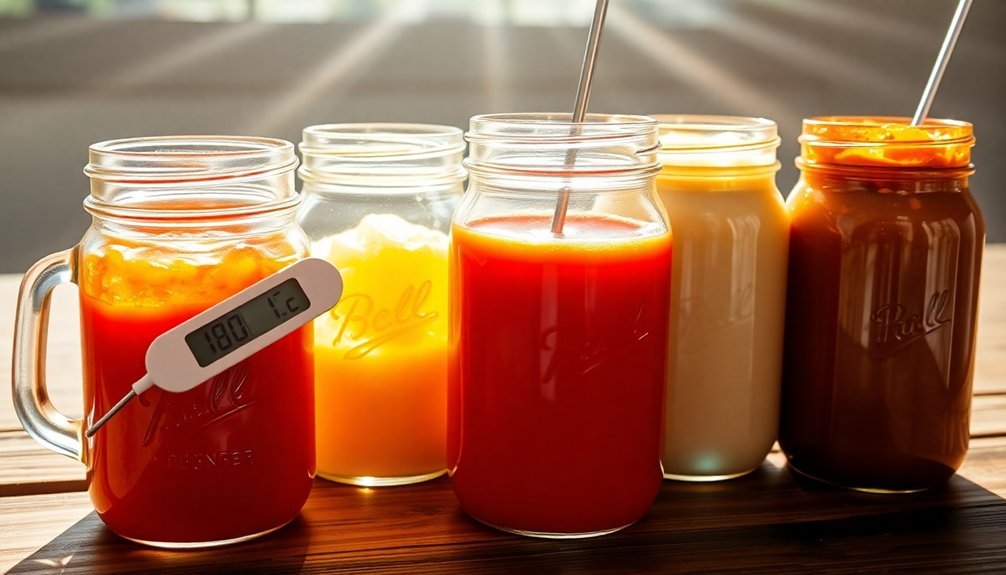
Maintaining precise temperature control stands as the cornerstone of successful sauce-making in solar cooking. You'll need to guarantee your solar cooker reaches at least 165°F to safely cook your sauces while avoiding the dangerous 40-140°F zone where bacteria thrive.
For best results, set up your solar cooker between 11:00 a.m. and 3:00 p.m. on a clear, sunny day. Since solar cookers can reach 200-300°F, you'll want to double your traditional cooking times.
Always use a thermometer to verify safe temperatures, and don't forget to wear sunglasses to protect your eyes from the reflective surfaces.
Watch your sauces closely for signs of spoilage, especially on humid days. If your sauce has been exposed to temperatures above 90°F for more than an hour, it's best to discard it.
Sauce Thickening Methods
When thickening sauces in a solar cooker, you'll need to adapt traditional methods to work with the unique heating patterns of solar energy.
Since sun cooking typically operates at lower temperatures than conventional methods, you'll find that starch-based thickeners like cornstarch slurries work particularly well. They don't require high heat to activate and won't alter your sauce's flavor.
- Use a cornstarch slurry (1:1 ratio with cold water) for quick, reliable thickening
- Choose reduction methods on bright, sunny days when you have plenty of time
- Add pureed vegetables like potatoes or squash for natural thickening
- Consider egg yolk tempering for cream-based sauces, but monitor temperature carefully
- Mix a cold roux separately and add it gradually to your sauce for even distribution
Best Times For Cooking
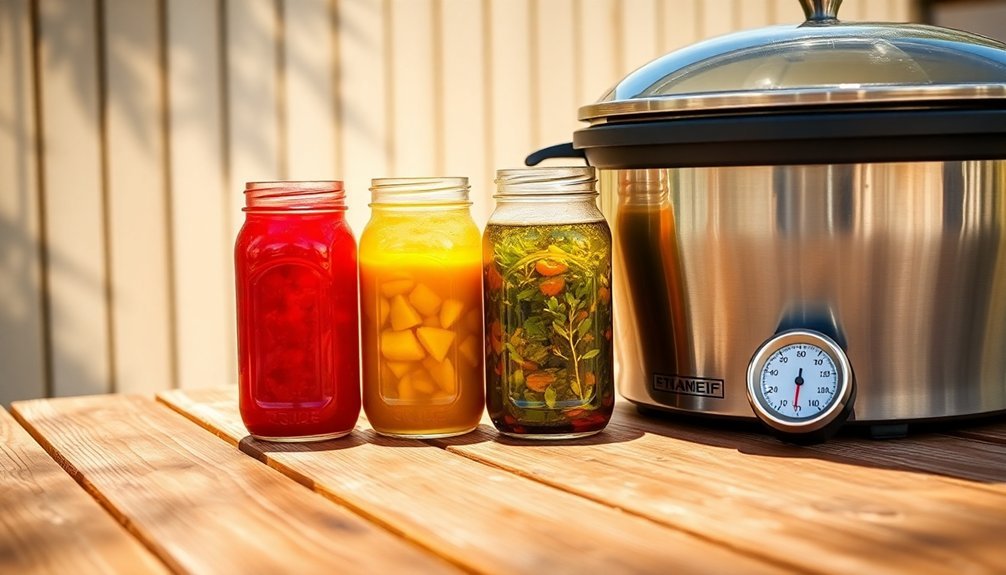
Three key time periods influence successful sauce preparation in sun cooking: morning setup, midday cooking, and late afternoon finishing.
In the morning, you'll want to focus on early preparation tasks. Chop your garlic, herbs, and sun-dried tomatoes, and measure out all spices and seasonings.
If you're using roasted peppers, prepare them now while the sun isn't too intense.
During peak sunlight hours, leverage the intense heat for your main cooking. This is when you'll want to heat your sauce components and blend ingredients together.
Add your aromatics first, followed by main ingredients like sun-dried tomatoes and cream.
Late afternoon is perfect for final touches. This is when you'll adjust seasonings, incorporate fresh herbs, and prepare for serving.
Add pasta water if needed, and finish with garnishes like parmesan cheese.
Storage And Food Safety
Proper storage methods guarantee your sun-cooked sauces remain safe and flavorful. Once you've prepared your sauce, store it in airtight containers away from direct sunlight and heat.
If you don't plan to use it immediately, refrigerate your sauce to extend its shelf life and prevent bacterial growth.
Keep your sauces out of the temperature danger zone (40°F – 140°F) to maintain food safety. You'll need to discard any sauce that's been in this range for over 3-4 hours.
- Use clean, airtight containers with tight-fitting lids
- Store unopened sauces in a cool, dry pantry
- Clean bottle rims after each use to prevent contamination
- Monitor for signs of spoilage like odd smells or discoloration
- Keep sauces refrigerated after opening for maximum freshness
Adjusting Traditional Sauce Recipes
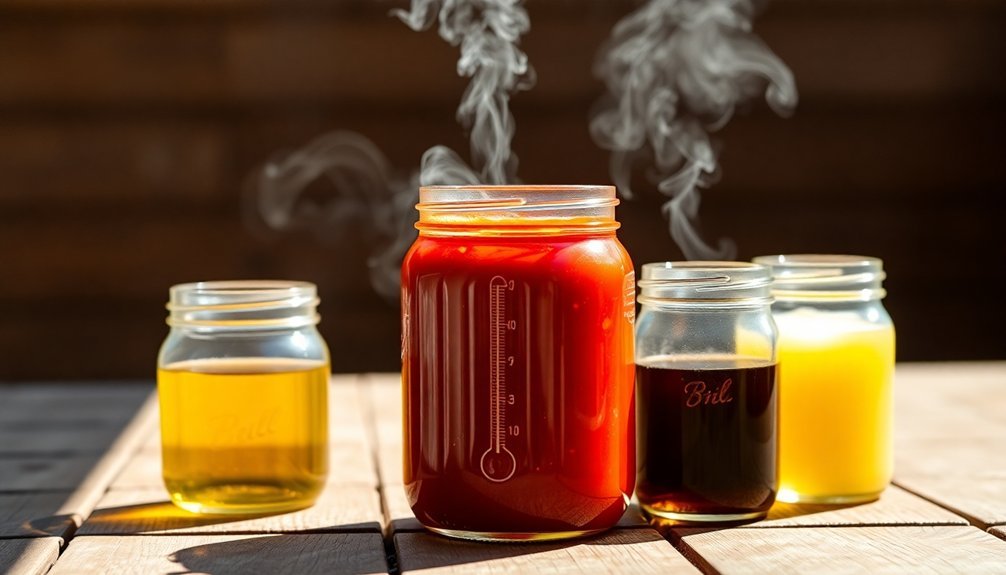
When adapting traditional sauce recipes for sun cooking, you'll need to carefully monitor and modify heat levels to prevent burning or separation.
You can maintain control by using shorter cooking times of 5-10 minutes and incorporating high smoke point oils like olive oil or sun-dried tomato oil.
To achieve the right consistency without direct heat, rely on natural thickeners such as grated cheese, tomato paste, or sunflower seed butter rather than traditional roux-based methods.
Modifying Heat Levels
Successfully modifying heat levels in sun-cooked sauces requires understanding how different ingredients and techniques affect spice intensity.
You'll find that controlling heat isn't just about adding or reducing spicy ingredients – it's about balancing flavors and using smart cooking methods. When sun cooking, you can adjust spiciness through various techniques while maintaining the sauce's intended character.
- Add coconut milk or heavy cream to cool down intense heat while adding richness
- Swap lime juice for vinegar to alter both heat perception and flavor profile
- Blend ingredients thoroughly to distribute and mellow the heat evenly
- Balance heat with salt and sugar adjustments to create harmony
- Use fresh herbs and coconut aminos as alternatives to reduce spiciness while maintaining flavor
Thickening Without Direct Heat
Beyond managing heat levels, mastering the art of thickening sauces without direct heat opens up new possibilities in sun cooking. You'll find that cornstarch or arrowroot slurries work efficiently – just mix 1 tablespoon with 2 tablespoons of cold water before incorporating it into your sauce.
| Method | Technique | Key Benefit |
|---|---|---|
| Starch Slurry | Mix cornstarch/arrowroot with cold water | Works without direct heat |
| Fats | Add butter or cream at the end | Helps sauce cling to food |
| Reduction | Simmer in wide pan | Concentrates flavors naturally |
| Vegetable Puree | Blend in cooked starchy vegetables | Adds nutrition and body |
| Bean Puree | Incorporate cooked legumes | Provides protein-rich thickness |
For dairy-based sauces, opt for cornstarch over arrowroot to avoid a slimy texture. You can also blend in cooked potatoes or winter squash to achieve thickness while adding nutritional value.
Solar Friendly Ingredients
Since solar cooking relies heavily on natural heat, choosing the right ingredients for your sauces and marinades is essential.
You'll find that basic pantry staples like olive oil, soy sauce, and vinegar work exceptionally well in solar cooking. For herbs and spices, dried versions often perform better than fresh ones, with garlic powder, paprika, and Provence herbs being popular choices.
- Acidic ingredients like lemon juice or white wine add depth while helping tenderize meats.
- Tomato-based products create rich, flavorful sauces without requiring extensive reduction.
- No-sugar-added condiments like ketchup provide concentrated flavors.
- Traditional seasonings such as bay leaves and dried oregano maintain their potency.
- Pomegranate juice offers natural sweetness without overpowering other flavors.
Remember to adjust quantities carefully, as solar cooking can intensify certain flavors over time.
Frequently Asked Questions
Can Glass Jars Be Used Instead of Pots for Solar Sauce Cooking?
Yes, you can safely use glass jars for solar sauce cooking. Just make sure they're properly sterilized, leave expansion space, and seal them tightly. Place them on reflectors and use oven bags for better heat retention.
How Do Cloudy Days Affect the Taste of Sun-Cooked Sauces?
You'll find that cloudy days don't actually affect your sauce's taste. While they might slow down the cooking process when using solar methods, the flavor remains unchanged as long as you achieve proper cooking temperatures.
Which Sauces Are More Likely to Separate During Solar Cooking?
You'll find that emulsion-based sauces like hollandaise and mayonnaise, cream-based sauces like bechamel, tomato sauces with high water content, and fat-heavy sauces like espagnole are most likely to separate during solar cooking.
Does Altitude Affect Solar Sauce Cooking Success Rates?
Yes, altitude will affect your sauce cooking success. You'll find better results at higher elevations where there's more direct sunlight. Your sauces will cook faster and more evenly in these conditions.
Can Solar-Cooked Sauces Be Safely Canned for Long-Term Storage?
You shouldn't can solar-cooked sauces for long-term storage as solar ovens can't maintain consistent high temperatures required for safe canning. Instead, you'll need to process them in a pressure canner or water bath.
In Summary
You'll find sun cooking your favorite sauces is both rewarding and eco-friendly. Remember to start early in the day, use proper temperature monitoring, and stick with ingredients that hold up well in solar cooking. While it takes longer than conventional methods, you'll get excellent results with tomato-based and cream sauces. Keep your solar cooker clean, store leftovers properly, and you'll enjoy delicious, sun-powered meals year-round.





Leave a Reply